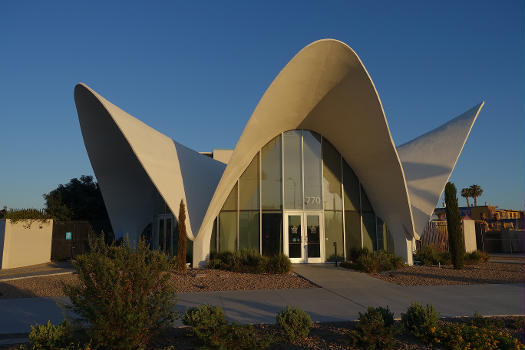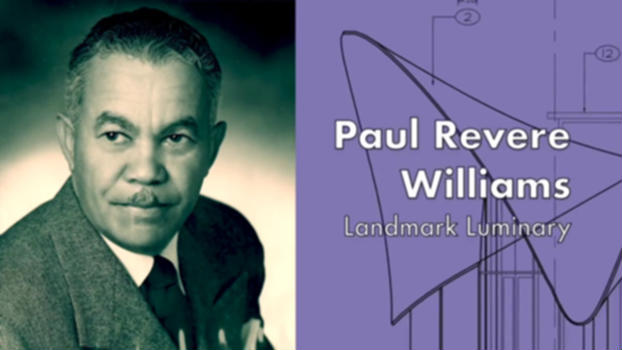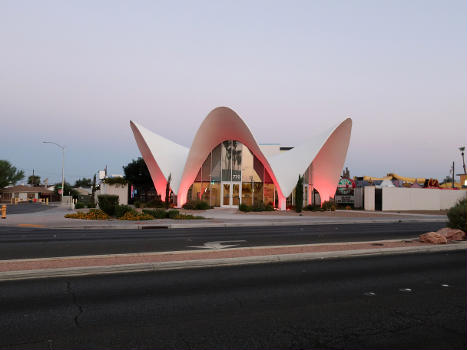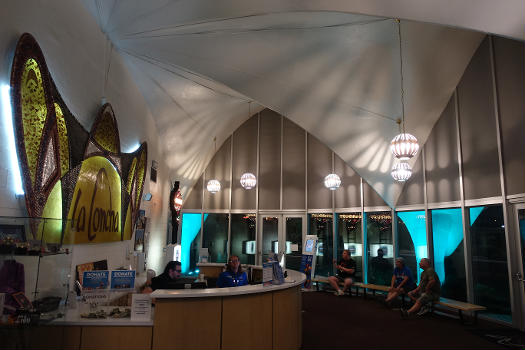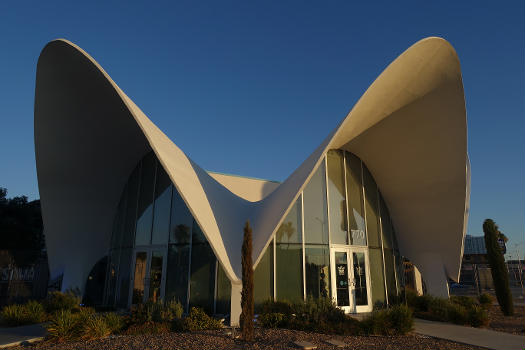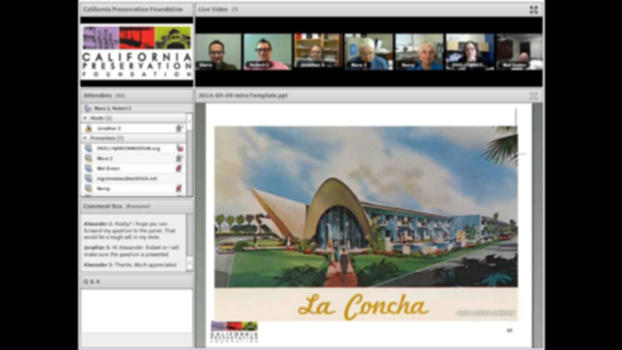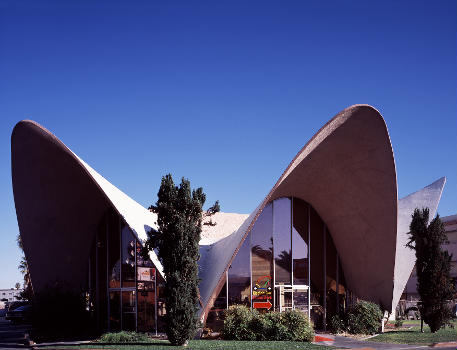General Information
| Other name(s): | La Concha Visitors’ Center®; La Concha Motel Lobby Building |
|---|---|
| Completion: | 1961 |
| Status: | in use |
Project Type
| Structure: |
Hyperbolic-paraboloid shell |
|---|---|
| Material: |
Reinforced concrete structure |
| Architectural style: |
Googie |
| Function / usage: |
original use: Motel current use: Museum building |
Awards and Distinctions
Location
| Location: |
Las Vegas, Clark County, Nevada, USA |
|---|---|
| Address: | 770 Las Vegas Boulevard North |
| Coordinates: | 36° 10' 37.29" N 115° 8' 7.41" W |
Technical Information
There currently is no technical data available.
Chronology
| 1961 | The shell is built at 2955 Las Vegas Boulevard South as the Lobby for the La Concha Motel. The architect is Paul Revere Williams. |
|---|---|
| 2004 | The La Concha Motel closes. |
| 2005 | While the actual hospitality buildings of the La Concha motel are torn down, the lobby serves as sales office for the Majustic condominiums (this project was cancelled in 2007). The shell is donated by the Doumani family to the Neon Museum and after sufficient money is raised for the relocation, the shell is cut up into eight pieces and then transported to its new location at 770 Las Vegas Boulevard North and rebuilt there. |
Excerpt from Wikipedia
The La Concha Motel was a motel that opened in 1961 and closed in 2004. It was designed by architect Paul Williams who was one of the first prominent African American architects in the United States and was also the architect who designed the first LAX theme building. It was located at 2955 Las Vegas Blvd South, on the Las Vegas Strip, in Winchester, Nevada, and was considered one of the best-preserved examples of 1950s Googie architecture. It is believed to be named after the Beach of La Concha in Spain.
History
The La Concha was opened by M.K. Doumani. When it opened, the La Concha was one of the larger properties on the Las Vegas Strip. Various celebrities had stayed at the motel, including Ronald Reagan, Ann-Margret, Flip Wilson, Muhammad Ali, and the Carpenters. The La Concha was featured in the 1995 film Casino. In its later years, the motel was owned by M.K. Doumani's sons: Edward and Fred Doumani. The Doumani family also owned the adjacent El Morocco.
In March 2001, Ed Doumani said he was considering options for the La Concha, saying, "Property taxes are huge and power is expensive." Doumani also complained of various costs such as a mandated beautification project of the Las Vegas Strip, in which each property had to help fund a new median with foliage and trees: "I had to pay $295,000 for what amounted to five palm trees. A large place can absorb that, we can't. We're probably going to knock (La Concha) down sometime this year. The land is more valuable than the buildings on it." At that time, the La Concha had been maintaining a high occupancy rate, despite lacking typical amenities such as a restaurant, casino, pool, and room service. Despite the motel's success, Doumani planned to replace it with a boutique hotel that would include condominiums and shopping, which he said would be a better use of the land.
Later in 2001, the property was approved for a 520-foot hotel tower, a 645-foot condominium tower, and a shopping mall. In late 2003, it was announced that La Concha would be closed and demolished to make room for a new project, later announced as the Majestic condominium/Conrad hotel resort. On December 11, 2003, a 100-room wing of the motel was demolished. Before being fully demolished, the La Concha was expected to continue operating for another six months, with a nine-story tower located in the back of the property, and with 139 rooms at the former El Morocco motel. The property was expected to be cleared by July 4, 2004.
The motel lobby was a concrete shell lobby. The motel sections of La Concha Motel and the former El Morocco Motel next door were torn down in 2005. By August 2005, only the lobby was still standing; it served as a sales office for the Majestic condominiums. By that point, Doumani had donated the lobby to the city's Neon Museum, which hoped to raise $600,000 to divide the lobby and reassemble it at the museum. The Doumanis had hoped to integrate the shell-shaped lobby into the Majestic project as the entrance to its shops or to a club. However, the lobby could not be worked into the design. In November 2005, the Las Vegas Convention and Visitors Authority agreed to provide $300,000 for the lobby's relocation effort. Later that month, a reception was held to help raise the rest of the money necessary for the lobby's relocation. In January 2006, the full $600,000 was in place. The lobby was relocated at the end of the year.
The La Concha Motel is now restored in the Neon Museum. The museum saved part of the hotel sign designed by the Young Electric Sign Company.
The La Concha motel neighbored the now-defunct El Morocco Motel, Riviera Hotel and Casino, and the Silver City Casino. The motel's sign, before it was removed, read "COLOR TV" and included advertisements.
The Majestic/Conrad project was ultimately cancelled. Triple Five Group purchased the land in 2007, and put it up for sale in 2014. In 2022, the property was sold to The Siegel Group for $75 million. The company plans to eventually redevelop the site, possibly with a hotel-casino.
Text imported from Wikipedia article "La Concha Motel" and modified on September 25, 2024 according to the CC-BY-SA 4.0 International license.
The Neon Museum in Las Vegas, Nevada, United States, features signs from old casinos and other businesses displayed outdoors on 2.62 acres (1.06 ha). The museum features a restored lobby shell from the defunct La Concha Motel as its visitors' center, which officially opened on October 27, 2012.
For many years, the Young Electric Sign Company (YESCO) stored many of these old signs in their "boneyard." The signs were slowly being destroyed by exposure to the elements.
The signs are considered by Las Vegas locals, business owners and government organizations to be not only artistically, but also historically, significant to the culture of the city. Each of the restored signs in the collection holds a story about who created it and why it is important.
History
The Neon Museum was founded in 1996 as a partnership between the Allied Arts Council of Southern Nevada and the City of Las Vegas. Today, it is an independent 501(c)3 non-profit. Located on Las Vegas Boulevard North, the Neon Museum includes the Neon Boneyard and the North Gallery.
The impetus behind the collecting of signs was the loss of the iconic sign from The Sands; after it was replaced with a new sign in the 1980s. There was no place to store the massive sign, and it was scrapped. After nearly 10 years of collecting signs, the Allied Arts Council of Southern Nevada and the city of Las Vegas worked together to create an institution to house and care for the saved signs. To mark its official opening in November 1996, the Neon Museum restored and installed the Hacienda Horse & Rider sign at the intersection of Las Vegas Boulevard and Fremont Street. However, access to the collection was provided by appointment only. Annual attendance was approximately 12–20,000 during this time.
In 2005, the historic La Concha lobby was donated to the museum by owners of the La Concha Motel, the Doumani family. Although it cost nearly $3 million to move and restore the La Concha, the plans to open a museum became concrete after the donation of the building, drawing a number of public and private grants and donations. In total, approximately $6.5 million was raised for the visitors' center, headquarters, a new park, and restoration of 15 major signs. The museum moved and reassembled the building 3.5 miles (5.6 km) north along Las Vegas Boulevard after cutting it into eight pieces.
In November 2009, the Neon Museum restored and installed the famous Silver Slipper sign across from its welcome center, and two more restored vintage signs were installed near the northern end of Las Vegas Boulevard to mark its designation as a National Scenic Byway.
Paid public admission commenced on October 27, 2012, replacing the prior appointment-only basis. Attendance during the first year was 60,461, exceeding the early estimate of 45–50,000 visitors.
After outgrowing its space in the former La Concha lobby shell, the museum moved its headquarters to old City Hall in 2016 and converted the offices into a museum store. In 2017, the museum purchased land for its first expansion since opening to the public in 2012. For its fifth anniversary, the Neon Museum offered free admission on October 28, 2017. In 2018, the Neon Museum administrative staff moved again to a space on the campus of the Las Vegas-Review Journal and opened a programming space there called Ne10 Studio.
Text imported from Wikipedia article "Neon Museum" and modified on September 25, 2024 according to the CC-BY-SA 4.0 International license.
Participants
Relevant Web Sites
- About this
data sheet - Structure-ID
20089556 - Published on:
25/09/2024 - Last updated on:
25/09/2024

